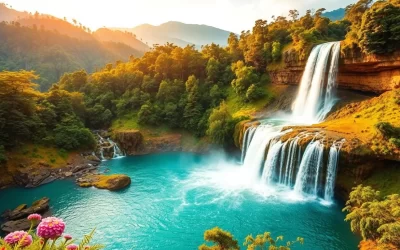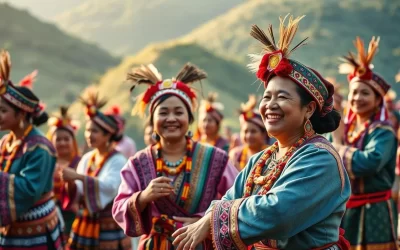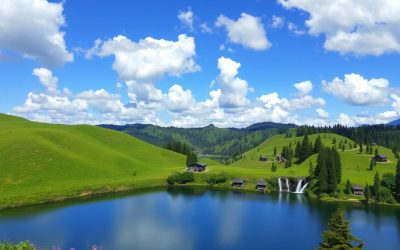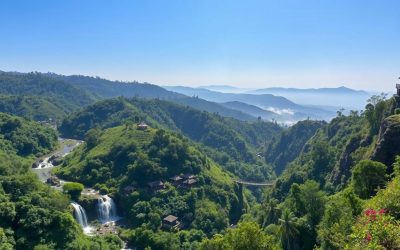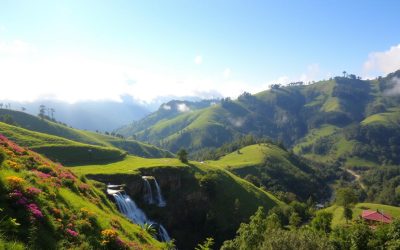✓ Accommodations✓ Flights✓ Rental Cars
Welcome to the culturally rich state of Meghalaya, nestled in the northeastern part of India. Known as the “abode of clouds,” this region boasts a diverse linguistic landscape that reflects its unique cultural heritage.
As you explore the languages spoken in this northeastern state, you’ll discover the official language status and the indigenous languages that have been preserved through generations, forming an integral part of the identity of its people.
Understanding the linguistic diversity of Meghalaya will give you deeper insights into the cultural fabric of this unique region. Whether you’re planning a visit, conducting research, or simply curious about language diversity, this guide provides a comprehensive overview of the linguistic landscape.
The Land of Clouds: An Overview of Meghalaya
Nestled in the Eastern Himalayas, Meghalaya is home to three ancient hill communities: the Khasi, the Jaintias, and the Garos. This northeastern state of India is known for its rich cultural heritage and breathtaking natural landscapes.
Geographical Setting and Demographics
Meghalaya’s diverse geography has played a significant role in shaping the demographics of the region. The state’s hilly terrain, comprising the Khasi Hills, Jaintia Hills, and Garo Hills, and its relative isolation have contributed to the distinct cultural identities of its inhabitants. You’ll find that the geography has not only influenced the lifestyle of the people but also preserved their traditional practices.
Cultural and Ethnic Diversity
The cultural landscape of Meghalaya is characterized by its rich tribal heritage. The Khasis and Jaintias, believed to be of Mongolian origin, and the Garos, with their Tibeto-Burman roots, together create a vibrant cultural mosaic. One of the unique aspects of Meghalayan society is its matrilineal system, where lineage and inheritance pass through the female line, a practice that distinguishes it from many other Indian societies.
You’ll encounter remarkable culture diversity in Meghalaya, with each tribal group maintaining distinct cultural practices, traditions, and languages. The state’s cultural identity has been preserved largely due to its geographical isolation, allowing you to experience traditions that have remained relatively unchanged for centuries.
- The Khasis, Jaintias, and Garos are the three main tribes of Meghalaya, each with their unique cultural practices.
- The cultural heritage of these communities is reflected in their traditional dances, music, festivals, and crafts.
- Meghalaya’s position in Northeast India has contributed to its distinct cultural identity.
Meghalaya, India: Official and widely spoken languages
As you explore Meghalaya, a state in north east India, you’ll discover a rich tapestry of languages that reflect its cultural diversity. The linguistic landscape of Meghalaya is characterized by a mix of indigenous languages and other tongues spoken across the state.
English as the Official Language
English serves as the official language of Meghalaya, playing a crucial role in administration, education, and official communications. You’ll find that English is widely used in government offices, schools, and other formal settings, facilitating communication across different linguistic groups within the state.
The use of English as the official language helps bridge the linguistic divide between various communities in Meghalaya, enabling effective governance and interaction with the outside world. As a result, proficiency in English is highly valued, particularly in urban areas and among the educated population.
Language Distribution Across the State
The language distribution in Meghalaya is diverse, with several languages spoken across different regions. According to the 2011 census, the linguistic breakdown is as follows:
- Khasi: 33.82%
- Garo: 31.6%
- Pnar (Jaintia): 10.69%
- Bengali: 6.44%
- Nepali: 1.85%
- War: 1.73%
- Hindi: 1.62%
- Hajong: 1.4%
- Assamese: 1.34%
- Others: 9.51%
You’ll notice that the language spoken varies significantly across different parts of the state. Khasi is predominantly spoken in the Khasi Hills, while Garo is the main language in the Garo Hills. Pnar, also known as Jaintia, is widely spoken in the Jaintia Hills region. This distribution largely follows geographical and tribal boundaries.
As you travel through Meghalaya, you’ll also encounter various dialects and lesser-known languages specific to particular villages or regions, highlighting the state’s rich linguistic diversity. The presence of non-indigenous languages like Bengali, Nepali, and Hindi, particularly in urban centers and border areas, adds to this diversity.
The linguistic diversity of Meghalaya is a reflection of its cultural heritage and the population‘s historical background. Understanding the languages spoken in this north east Indian state provides valuable insights into its societal fabric and regional identity.
Khasi: The Predominant Indigenous Language
As you explore the linguistic landscape of Meghalaya, you’ll find that Khasi stands out as a predominant indigenous language. With its rich history and cultural significance, Khasi plays a vital role in the identity of the region.
Origin and Linguistic Classification
The Khasi language has a unique origin and linguistic classification. You can trace its roots to the Mon-Khmer branch of the Austroasiatic language family. This classification highlights the language’s distinctiveness and its connection to other languages in the region.
Dialects and Regional Variations
Khasi, like many languages, has its dialects and regional variations. You may notice differences in pronunciation and vocabulary across different areas where Khasi is spoken. These variations add to the language’s richness and diversity.

Script and Written Tradition
The Khasi language originally had no script of its own. However, with the arrival of Christian missionaries in the 19th century, the Roman script was introduced for Khasi. You can attribute the development of written Khasi to the work of Welsh missionary Thomas Jones, who arrived in the Khasi Hills in 1841 and developed the first Khasi alphabet and grammar.
When you examine Khasi writing, you’ll notice it uses the Roman alphabet. Before the arrival of missionaries, Khasi existed primarily as an oral language without a standardized written form. The introduction of a writing system has played a crucial role in education, allowing Khasi to be taught formally in schools throughout the Khasi Hills in North-East India.
Today, you can find a growing body of Khasi literature, including poetry, novels, and academic texts, which have developed since the establishment of the writing system. The standardization of written Khasi has been instrumental in promoting the language and preserving its cultural heritage.
| Aspect | Description | Impact |
|---|---|---|
| Introduction of Roman Script | Christian missionaries introduced the Roman script for Khasi. | Enabled the development of written Khasi. |
| Development of Written Tradition | Thomas Jones developed the first Khasi alphabet and grammar. | Facilitated the creation of Khasi literature. |
| Role in Education | Khasi is taught formally in schools. | Promotes the language and preserves cultural heritage. |
Garo: The Second Major Language
As you explore the linguistic landscape of Meghalaya, you’ll discover that Garo stands out as a significant language. Garo is not only widely spoken but also holds a crucial place in the cultural and educational fabric of the region.
Historical Background and Development
The development of the Garo language is closely tied to the efforts of Christian missionaries who introduced the Roman alphabet in the late 19th century. This marked the beginning of a written tradition for Garo, enabling the creation of literature and educational materials. The American Baptist missionaries played a pivotal role in this process by compiling the first Garo dictionary and grammar books, laying the foundation for language development.
Linguistic Features and Classification
Garo belongs to the Tibeto-Burman language family, a branch of the larger Sino-Tibetan languages. Understanding its linguistic features is crucial for appreciating its uniqueness and the role it plays in the region’s cultural identity. The language has various dialects, reflecting the diversity within the Garo community.
Written Form and Literature
The written form of Garo, using the Roman alphabet, has facilitated the growth of a rich literary tradition. Initially, Garo literature consisted of religious texts and translations. Over time, it has expanded to include original creative works such as poetry, short stories, and novels, contributing significantly to the language’s literary heritage. Today, Garo is taught as an academic subject up to the postgraduate level, highlighting its importance in education. The efforts of Christian missionaries and subsequent language development initiatives have been instrumental in this achievement.
In educational institutions within the Garo Hills, Garo is used as a medium of instruction in primary education, with a transition to English in higher grades. This bilingual approach supports students in their academic journey while preserving their linguistic heritage. The recognition of Garo as a modern Indian language by the Government of India further underscores its significance.
Pnar/Jaintia: The Third Indigenous Language
In the heart of Meghalaya lies the Jaintia Hills, where the Pnar language plays a crucial role in daily life and cultural practices. The Jaintias, like the Khasis, are believed to be remnants of the first Mongolian overflow into India. They established themselves in their present homeland in the remote past and, owing primarily to their geographical isolation, succeeded in maintaining their independence until the consolidation of the British administration in this part of India.
Relationship with Khasi Language
The Pnar language is closely related to the Khasi language, sharing linguistic similarities and cultural significance. This relationship is evident in the way both languages have preserved the cultural heritage of their respective communities. As you explore the linguistic landscape of Meghalaya, you’ll notice that Pnar and Khasi languages have coexisted, influencing each other in various ways.
Some key aspects highlighting their relationship include:
- Linguistic similarities in grammar and syntax
- Shared cultural practices and traditions
- Historical ties between the Jaintia and Khasi communities
Cultural Significance and Usage
The Pnar language serves as a crucial marker of Jaintia cultural identity and heritage. It is the primary language of daily communication in the Jaintia Hills, used in homes, local markets, and community gatherings. Many traditional songs, stories, and proverbs are preserved in Pnar, making it essential for cultural transmission.
When attending traditional Jaintia festivals and ceremonies, you’ll hear Pnar used in ritual contexts, highlighting its importance in religious and cultural practices. Jaintia elders often emphasize the importance of preserving the Pnar language as a way of maintaining their cultural distinctiveness in an increasingly globalized world.
Key aspects of Pnar’s cultural significance include:
- Use in daily communication and community gatherings
- Preservation of traditional songs, stories, and proverbs
- Importance in religious and cultural practices
Other Indigenous Languages and Dialects
Beyond the major languages, Meghalaya’s linguistic landscape is dotted with numerous smaller tribal languages. As you explore the state’s diverse linguistic heritage, you’ll discover several lesser-known languages spoken by smaller communities throughout Meghalaya.
War, Lyngngam, and Other Khasi Dialects
The Khasi language has several dialects, including War and Lyngngam, which are spoken in different regions of Meghalaya. These dialects, while related to the standard Khasi language, have distinct features and are often specific to certain tribes or geographic areas.
For instance, the War dialect is spoken by the War tribe, who primarily reside in the East Khasi Hills and West Jaintia Hills districts. The Lyngngam dialect, on the other hand, is spoken by a subgroup of the Khasi people living in the West Khasi Hills district.
| Dialect | Region | Population |
|---|---|---|
| War | East Khasi Hills, West Jaintia Hills | Approximately 30,000 |
| Lyngngam | West Khasi Hills | Around 20,000 |
Lesser-Known Tribal Languages
In addition to the major indigenous languages, Meghalaya is home to several lesser-known tribal languages spoken by smaller communities. You might encounter the Hajong language, spoken by the Hajong tribe primarily in parts of the Garo Hills and neighboring areas of Assam.
- The Biate language is spoken by a small community in the Jaintia Hills.
- The Koch language is found among the Koch community, particularly in the Garo Hills.
- Other languages like Rabha and Dimasa are spoken by communities that often straddle state boundaries in the northeast region.
These smaller language communities face significant challenges in maintaining their linguistic heritage as younger generations increasingly shift to more dominant languages. Efforts to document and preserve these languages are crucial for maintaining the cultural diversity of Meghalaya’s population.

Non-Indigenous Languages in Meghalaya
While Meghalaya is known for its indigenous languages, there’s also a significant presence of non-indigenous languages spoken across the state. This linguistic diversity is a reflection of the state’s cultural richness and its position as a melting pot of various ethnic and linguistic groups.
Bengali, Nepali, and Assamese
In Meghalaya, you’ll find communities that speak Bengali, Nepali, and Assamese, among other non-indigenous languages. These languages are spoken by people who have migrated to Meghalaya for various reasons, including work, education, and marriage. For instance, Bengali is spoken by people who have migrated from neighboring Bangladesh or from other parts of India where Bengali is widely spoken.
A closer look at the linguistic landscape reveals that these languages play a significant role in the daily lives of the people who speak them. For example, Nepali is spoken by the Gorkha community, which has a significant presence in Meghalaya. Assamese, on the other hand, is spoken by people who have migrated from the neighboring state of Assam.
Hindi and Other Indian Languages
When you visit Meghalaya, you’ll find that Hindi is spoken by about 1.62% of the population, primarily in urban areas and among government employees transferred from other parts of India. Despite being India’s most widely spoken language, Hindi has limited usage in Meghalaya compared to other states, reflecting the region’s distinct linguistic history.
Other Indian languages like Gujarati, Punjabi, and Tamil are also spoken by small communities of traders, professionals, and government employees who have settled in the state. The presence of these languages adds to the linguistic diversity of Meghalaya, making it a unique cultural melting pot.
| Language | Percentage of Speakers |
|---|---|
| Hindi | 1.62% |
| Others | 9.51% |
The linguistic diversity in Meghalaya is a testament to the state’s cultural richness and its ability to accommodate and integrate different linguistic and ethnic groups. As you explore Meghalaya, you’ll notice how this diversity contributes to the vibrant cultural landscape of the state.
Language Families in Meghalaya
As you explore Meghalaya, you’ll discover that the state is linguistically diverse, with languages from various families. This diversity is a reflection of the state’s rich cultural heritage and its strategic location in Northeast India.
Austroasiatic Language Family
The Austroasiatic language family is represented in Meghalaya primarily through the Khasi language. Khasi is spoken by a significant portion of the population and is an important part of the cultural identity of the Khasi people.
Some key features of the Austroasiatic language family include:
- Unique grammatical structures
- Distinctive sound systems
- Rich oral traditions
Tibeto-Burman Language Family
The Tibeto-Burman language family is another significant linguistic group in Meghalaya, with Garo being a prominent language within this family. Garo is spoken in the Garo Hills region and is closely related to other languages such as Bodo and Kachari.
Some notable characteristics of the Tibeto-Burman language family include:
- Tonal systems
- Specific word order patterns
- Morphological structures that distinguish them from other language families
Here’s a comparison of the two language families found in Meghalaya:
| Language Family | Primary Language | Key Features |
|---|---|---|
| Austroasiatic | Khasi | Unique grammatical structures, distinctive sound systems |
| Tibeto-Burman | Garo | Tonal systems, specific word order patterns, distinctive morphological structures |
The intersection of these language families in Meghalaya creates a fascinating linguistic landscape, with evidence of mutual influence and language contact.
The Role of Christian Missionaries in Language Development
Christian missionaries played a pivotal role in shaping the linguistic identity of Meghalaya by introducing the Roman script and fostering early literature. Their efforts not only helped in preserving the local languages but also paved the way for their development.
Introduction of Roman Script
The introduction of the Roman script was a significant milestone in the development of Meghalaya’s indigenous languages, particularly Khasi and Garo. This script enabled the creation of written forms for these languages, which were previously unwritten. You can see how this facilitated the translation of religious texts and the development of early literature.
As a result, the local population gained access to educational materials in their native languages, enhancing their ability to engage with formal education. The use of the Roman script also helped in standardizing the languages, making them more cohesive and easier to learn.
Early Literature and Translations
When you explore the early literature of Meghalaya’s languages, you’ll find that religious texts, particularly Bible translations, were among the first works published in Khasi and Garo. These translations required missionaries to develop specialized vocabulary for religious concepts, often by borrowing or adapting existing words from the languages.
The development of literature in these languages gradually expanded beyond religious texts to include educational materials, folk tales, and eventually original creative works. Early dictionaries and grammar books created by missionaries not only facilitated language learning but also established standardized forms of previously unwritten languages.
Today, Khasi and Garo languages are taught as subjects up to the postgraduate level, a testament to the foundational work done by Christian missionaries in language development and education. You can observe how their efforts have contributed to the rich cultural heritage and linguistic diversity of the region.
Language in Education System
The education system in Meghalaya is characterized by a unique blend of languages, reflecting the state’s cultural diversity. As you delve into the specifics, you’ll find that language plays a pivotal role in shaping the academic landscape.
Medium of Instruction in Schools
In schools across Meghalaya, English is predominantly used as the medium of instruction. This is a reflection of its status as the official language for administrative and judicial purposes, including proceedings in the High Court. However, indigenous languages like Khasi and Garo are also given significant importance, being taught as subjects up to the postgraduate level.
You’ll find that the curriculum is designed to promote linguistic diversity, with a focus on preserving the cultural heritage of the state. This approach not only enhances the students’ proficiency in their native languages but also fosters a deeper understanding of their cultural roots.
Higher Education and Language Studies
When you explore higher education options in Meghalaya, you’ll discover that institutions like North-Eastern Hill University (NEHU) in Shillong offer a range of programs in language studies. Both Khasi and Garo are offered as academic subjects up to the postgraduate level, allowing students to pursue advanced studies in their native languages.
| Language | Level of Study | Institution |
|---|---|---|
| Khasi | Postgraduate | NEHU |
| Garo | Postgraduate | NEHU |
Moreover, language departments in these institutions conduct research on indigenous languages, documenting dialects, developing teaching materials, and preserving linguistic heritage. You’ll also find specialized programs that train teachers to teach Khasi, Garo, and other local languages in schools throughout the state in the North East region.
As you examine academic publishing in Meghalaya, you’ll notice a growing body of scholarly work in and about indigenous languages, including dictionaries, grammars, and linguistic analyses. This not only contributes to the academic discourse but also aids in the preservation and promotion of the region’s linguistic diversity.
Languages in Administration and Governance
As you explore the administrative functions in Meghalaya, you’ll notice the significant role languages play in governance. The state’s administrative and governance framework is designed to accommodate its linguistic diversity, ensuring effective communication and service delivery to its citizens.
Official Communications and Documents
In Meghalaya’s administration, English is predominantly used for official communications and documents. However, the state also recognizes the importance of local languages in governance. You’ll find that official documents are often translated into local languages such as Khasi, Garo, and Pnar/Jaintia to ensure inclusivity and accessibility.
The use of local languages in official contexts is particularly significant in the Autonomous District Councils, where they play a crucial role in preserving cultural heritage and promoting local governance.
Language Use in Autonomous District Councils
Meghalaya has three Autonomous District Councils: the Khasi Hills Autonomous District Council, Garo Hills Autonomous District Council, and Jaintia Hills Autonomous District Council. These councils operate under the Sixth Schedule of the Constitution of India, giving them significant autonomy in governance.
| Autonomous District Council | Predominant Language Used | Role in Governance |
|---|---|---|
| Khasi Hills Autonomous District Council | Khasi | Preserving Khasi culture and traditions |
| Garo Hills Autonomous District Council | Garo | Promoting Garo culture and governance |
| Jaintia Hills Autonomous District Council | Pnar/Jaintia | Addressing traditional customs and practices |
In these councils, you’ll observe a flexible approach to language use, with local languages being used alongside English for discussions, debates, and local governance matters. This approach ensures that all community members can participate in the governance process.
Language Preservation Efforts
In Meghalaya, the preservation of indigenous languages is being achieved through a combination of formal initiatives and grassroots efforts. As you explore the state, you’ll discover a range of activities aimed at safeguarding its rich linguistic heritage.
Government Initiatives
The government of Meghalaya has launched several initiatives to promote and preserve indigenous languages. These include incorporating local languages into the school curriculum and supporting the development of language documentation projects. The state’s Legislative Assembly, comprising 60 members from various hills, plays a crucial role in policy-making related to language preservation.
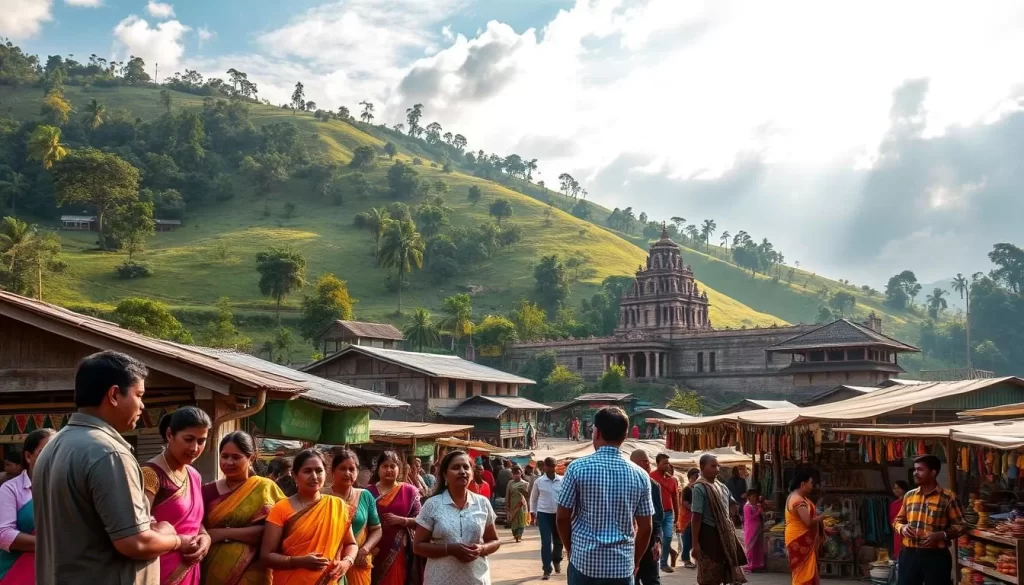
Community-Based Language Conservation
Community-based efforts are vital to language preservation in Meghalaya. You’ll find that local cultural organizations are actively involved in conducting language classes, documenting oral traditions, and organizing cultural events that celebrate linguistic heritage. In villages across remote areas, community elders serve as repositories of specialized vocabulary and traditional stories, playing a crucial role in preserving linguistic knowledge. Community radio stations and local media outlets also contribute by broadcasting content in indigenous languages, thus providing both entertainment and a platform for language use.
When attending local festivals and cultural events, you’ll experience the rich linguistic traditions of Meghalaya through performances of traditional songs, poetry, and storytelling. Furthermore, community groups are advocating for stronger language policies, increased educational resources, and greater media presence for indigenous languages. Intergenerational language transmission programs, where elders teach children traditional knowledge through their native language, are also being implemented to ensure cultural continuity.
Multilingualism in Meghalaya Society
The multilingual nature of Meghalaya’s society is a fascinating aspect of its cultural fabric, woven together by various languages and dialects. As you delve into the linguistic landscape of Meghalaya, you’ll discover that multilingualism is not just a common phenomenon but an integral part of the societal identity.
Code-Switching and Language Mixing
One of the notable features of multilingualism in Meghalaya is the prevalence of code-switching and language mixing. When you speak with Meghalayans about their languages, you’ll discover strong emotional connections between language and cultural identity, particularly among the indigenous tribal communities. For many Khasi, Garo, and Jaintia people, their respective languages serve as primary markers of ethnic identity and cultural belonging.
Code-switching between indigenous languages and English is common, especially in formal and educational settings. This linguistic flexibility reflects the complex attitudes toward English, which is simultaneously viewed as a language of opportunity and education while sometimes perceived as a potential threat to indigenous language vitality.
| Language | Primary Speakers | Context of Use |
|---|---|---|
| Khasi | Khasi people | Community gatherings, traditional ceremonies |
| Garo | Garo people | Local administration, community events |
| English | Educated population | Education, official communications |
Language Attitudes and Identity
As you explore language attitudes in Meghalaya, you might notice generational differences, with elders often expressing concern about language shift while younger people navigate multiple linguistic identities. Community leaders often frame language preservation not just as linguistic conservation but as protection of cultural knowledge, worldviews, and traditional practices.
Language choice in public settings can signal political positions, social affiliations, and personal identities in Meghalaya’s multilingual context. Debates about language purity, borrowing, and standardization reflect deeper questions about cultural authenticity and adaptation in a changing world.
Understanding these dynamics is crucial for appreciating the complex interplay between language, culture, and identity in Meghalaya. As you engage with the local communities, you’ll find that their languages are not just means of communication but are deeply intertwined with their sense of self and cultural heritage.
Challenges Facing Indigenous Languages
As you explore the linguistic landscape of Meghalaya, you’ll notice the challenges indigenous languages face in the modern era. The rich tapestry of languages in this region is threatened by various factors, including globalization and the need for standardization.
Globalization and Language Shift
Globalization has brought about significant changes in the way people live, communicate, and interact. You’re likely to observe that younger generations in Meghalaya are increasingly drawn to more widely spoken languages, such as English or Hindi, for better economic opportunities and global connectivity. This shift can lead to a decline in the use of indigenous languages, especially among the younger population.
When you examine the impact of globalization on language, you’ll find that it’s not just the language itself but also the cultural identity associated with it that’s at risk. The challenge lies in balancing the benefits of globalization with the preservation of indigenous languages and cultures.
Standardization Issues
Standardization is another critical issue facing indigenous languages in Meghalaya. When you study language planning in the region, you’ll encounter debates about which dialect should serve as the basis for the written standard. You’ll find that standardization efforts can sometimes create tension between speakers of different dialects, as elevating one variety to standard status may marginalize others.
The table below summarizes some of the key challenges in standardizing indigenous languages:
| Challenge | Description | Impact |
|---|---|---|
| Dialect Selection | Choosing a dialect for standardization | Potential marginalization of other dialects |
| Terminology Development | Creating consistent terminology for modern concepts | Difficulty in maintaining linguistic consistency across dialects |
| Orthography | Deciding on spelling conventions and punctuation rules | Variability in written forms, potentially confusing readers |
As you can see, the challenges facing indigenous languages in Meghalaya are complex and multifaceted. Addressing these issues requires careful consideration of linguistic, social, and cultural factors.
Digital Age and Language Technology
In today’s digital world, you’re witnessing a fascinating phenomenon: the adaptation and vibrant use of Meghalaya’s indigenous languages online. The internet and digital platforms have opened up new avenues for language expression, preservation, and community building.
Online Resources and Applications
The development of online resources and applications has been instrumental in promoting Meghalaya’s indigenous languages. You’re likely to find various digital dictionaries, language learning apps, and websites dedicated to these languages. These resources not only help in language learning but also provide a platform for language documentation and preservation.
For instance, language learning apps have made it possible for younger generations to engage with their linguistic heritage in an interactive and engaging manner. Moreover, online forums and discussion groups have emerged, where speakers of indigenous languages can share their knowledge, discuss cultural nuances, and support one another in language preservation efforts.

Social Media and Indigenous Languages
Social media platforms have become a significant domain for the use of Meghalaya’s indigenous languages. When you browse platforms like Facebook, WhatsApp, and Instagram, you’ll find vibrant communities of Khasi, Garo, and Pnar speakers using their languages for everyday digital communication. Younger generations are creating innovative content, including memes, short videos, and music that blend traditional elements with contemporary themes.
- You’ll notice code-mixing practices where indigenous languages are written informally, often incorporating English words and expressions.
- Hashtags in indigenous languages help create virtual communities and increase the visibility of content in these languages.
- Language activists leverage social media to advocate for indigenous language rights, organize events, and share resources.
- Digital platforms allow diaspora communities to maintain connections with their linguistic heritage, participating in language communities despite geographical distance.
By embracing digital platforms, Meghalaya’s indigenous language speakers are not only preserving their languages but also ensuring their relevance in the modern world.
Conclusion
As you finish exploring the linguistic landscape of Meghalaya, it’s clear that this northeastern Indian state is a true mosaic of languages. You’ve discovered a fascinating world where English, the official language, coexists with a rich tapestry of indigenous languages like Khasi, Garo, and Pnar/Jaintia, as well as other non-indigenous languages.
The three major indigenous languages represent different language families and are vital carriers of cultural identity for their respective communities. Historical factors, including missionary activities and colonial influences, have shaped the development of written traditions and educational practices in the state. You now understand the complex challenges facing indigenous languages in the modern era, from globalization and language shift to standardization issues and the need for digital adaptation.
Language preservation efforts, both governmental and community-based, work to maintain linguistic diversity in the face of homogenizing pressures. Multilingualism is a common phenomenon in Meghalayan society, with code-switching and language mixing being everyday practices. As you reflect on Meghalaya’s linguistic diversity, you can appreciate how languages serve not just as communication tools but as repositories of cultural knowledge, worldviews, and identities.
This guide has provided you with a comprehensive overview of the official and widely spoken languages of Meghalaya, making it a valuable resource for anyone interested in the linguistic landscape of this unique state. Whether you’re planning to visit, conducting research, or simply expanding your understanding of India’s linguistic diversity, you’ve gained a deeper appreciation for the people and their cultural heritage.
The above is subject to change.
Check back often to TRAVEL.COM for the latest travel tips and deals.

